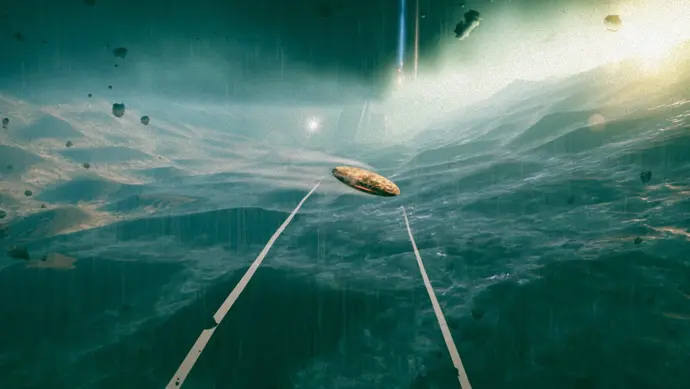An unearthly voyage without endless activities.
This place is lonely. Dark, even. You’ll sometimes be accompanied by a smooth, depressing soundtrack, but for the most part, it’s just you, your strange spaceship, and the sound of the air rushing past your ears.
Even though it occasionally resembles the kind of UFO pulp fiction that has been taught to us (if you suddenly saw an image of an aerodynamic disc zipping silently across the sky, that’s exactly what I mean), you might be surprised to hear that your ship can’t maintain this iconic shape for very long because the momentum you build up will quickly evaporate once you’re in the air. In other words, its default shape is a spherical mass, a solid ball that rolls and bumps around the ground, gaining velocity as it passes through the peaks and valleys of the terrain until you can jump back up into the air and glide again.
Exo One is described as a gravity-defying game about interplanetary exploration by its developer, Exbleative. While I agree with the latter claim, I’m not so sure about the former. Even though this was an enemy-free game, I still found myself battling gravity often, battling the landscape below to maximize my cruise speed and glide time, and seldom feeling like I ever got it perfect.
The majority of the knowledge you acquire will be practically acquired on the spot, and the controls are straightforward: you may roll, glide, and dive. Additionally, you may increase the force of gravity, which should improve your projection’s height and speed, at least in theory. Even after obtaining a few of the power-up items in the game, I was never able to sustain my glide for as long as I would have wanted. However, a quick dive may also assist extend your glide. Yes, there are stages where you get some assistance with this. On one planet, you are supported by iridescent blue particles, while on another, you can really skim the waves like a pebble. The majority of the time, however, your energy will vanish and you will return to the very un-aerodynamic shape of a stone marble. Your energy burns white-hot in the center of your spaceship until it ultimately splutters into darkness.
It all feels extremely Zen at first. To the tune of bold electric guitars and woodwind instruments, you slide, glide, race, and dive while maximizing your height and travel distance by taking use of the soft outlines of the surrounding terrain. In Exo One, there are little expectations placed on you; you cannot fail or die precisely (though you may restart the planet if you get lost), and you advance by finding and scaling the “transport monolith” that is situated at the beginning of each level. Of course, Exo One doesn’t tell you this directly—very nothing does, in fact—but the “giant light in the sky” is a bit of a clue.
But after a few hours, I discovered that my interplanetary journey was less calm and more boring. Exo One is obviously not too long, but each planet you see becomes a little bit harder to navigate, forcing you to utilize wind currents and tree trunks to travel around and get to the monolith. Several times, especially later in the game when you had to approach openings and currents a bit more carefully than previously, I found myself battling the camera.
I’m not the kind of person who likes to take the scenic way by nature. I travel because I want to go there, and I have never in my life felt the need to take a “lovely” stroll. This is perhaps the reason why I’m not as excited about games as I am about others, such as Exo One and yes, even Journey (I know that’s sacrilegious, but the lack of direction and, well, purpose, annoyed me, I’m afraid). Even while Exo One’s soothing soundtrack and the sound of air rushing past your ears as moisture specks land on your screen are indescribable, I couldn’t help but get more eager to find the next monolith so I could go on to the next planet and leave that one too.
You’ll be flying over lush woods, sandy dunes, boiling lava, choppy seas, and dark, alien pyramids as you explore the planets’ magnificent diversity. You may even manipulate the terrain underneath you to extend your flight time. Which is really a good thing since the world seems best from a height; if you come too near, which is unavoidable because you often have to fall to the ground in order to gain more speed, you could find that the textures of those breathtaking vistas are less striking at closer range.
However, as you go from world to planet, you’ll be treated to little vignettes that provide context for the events leading up to this one. A picture in a frame on the wall. The sound of voices in the distance. That’s what kept me playing through to the very end out of everything. The curiosity to find out how we got here, in this odd spacecraft with “nothing in the design for a cockpit, no internal space for a pilot,” as one incorporeal voice informed us.
That piqued my interest the most out of everything: if there isn’t room for a pilot, then who or what is operating this machine? To be precise, who are we?
There is room (pun oh-so-definitely intended) for exploration, and I’m sure there are secrets to be found if you venture off the path and search beyond the transport monolith, but I found that controlling the ship, especially in later levels, was more annoying than difficult. Exo One has an intriguing plot and a unique idea, but beyond that, there isn’t enough to do in the game to persuade me to go back, especially considering the absence of action and agency.
